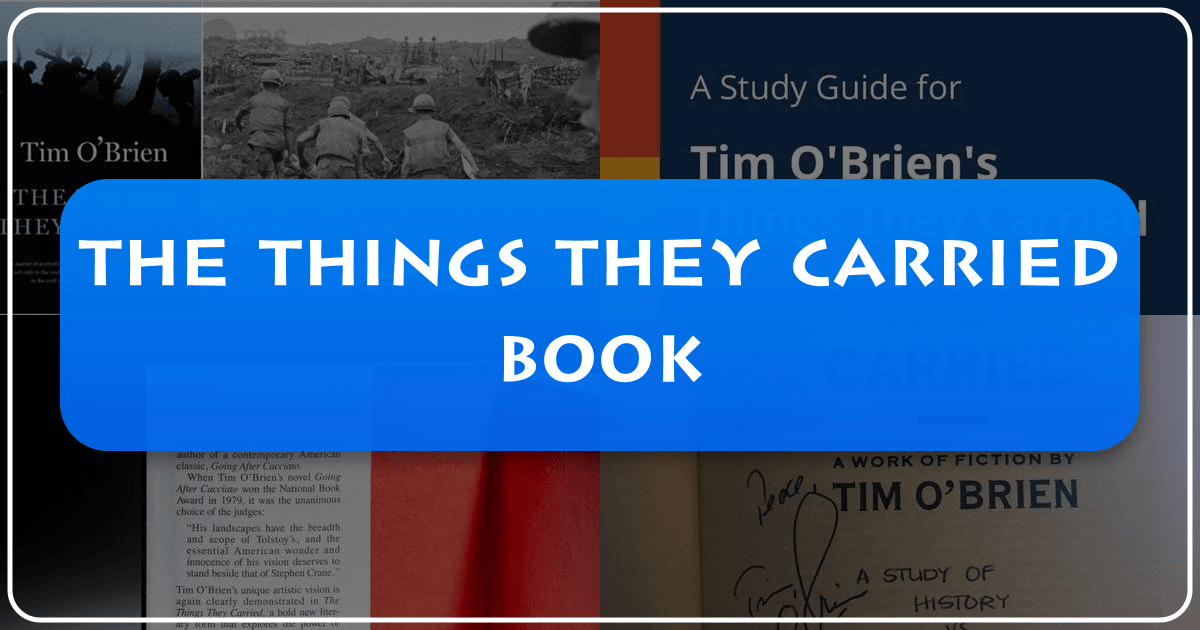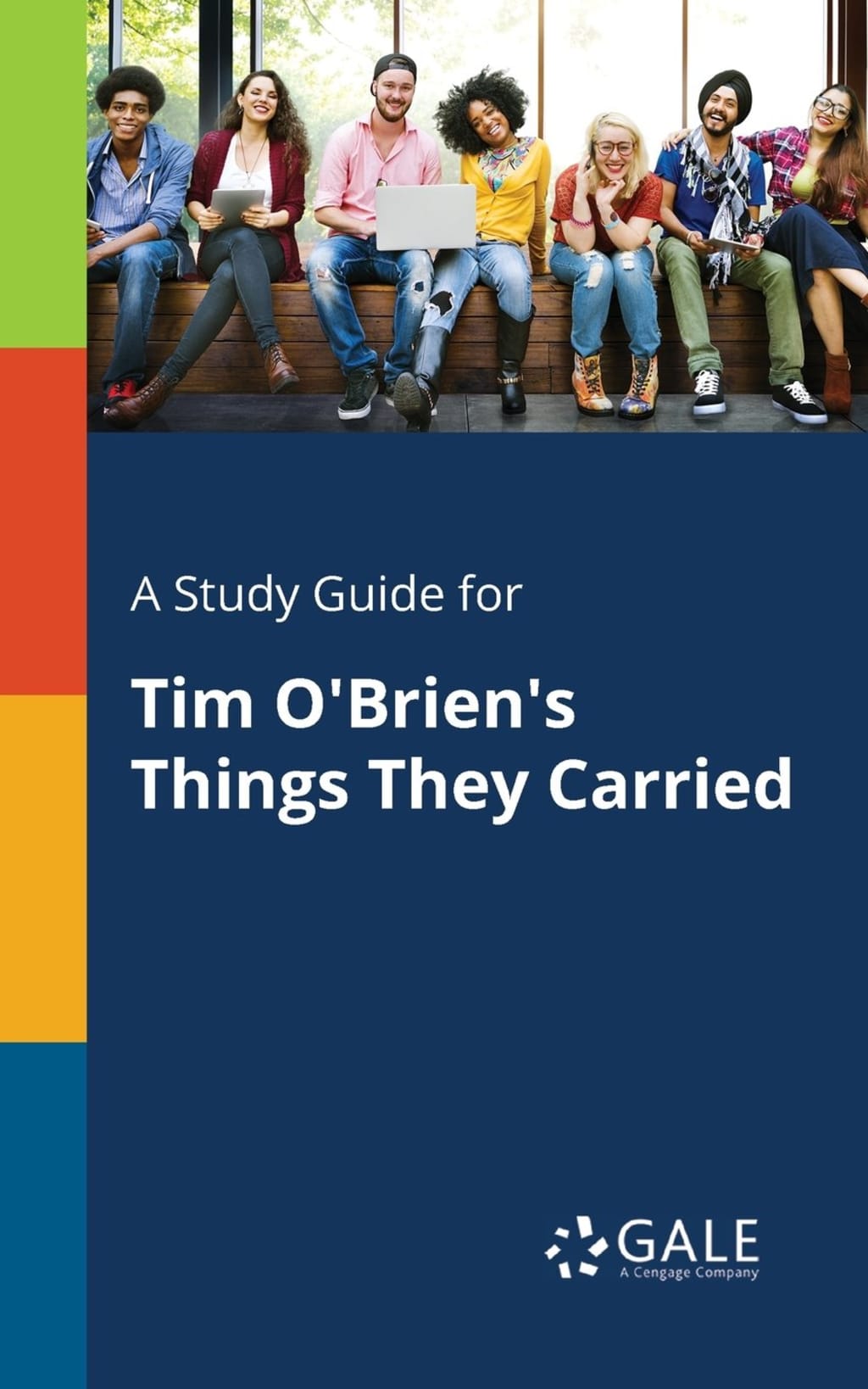The Things They Carried: A Deep Dive into Tim O'Brien's Masterpiece

Tim O’Brien’s The Things They Carried, a seminal work of American literature, transcends its status as a Vietnam War novel to become a profound exploration of memory, truth, storytelling, and the enduring human spirit. Published in 1990, this collection of interconnected short stories has resonated with readers for decades, earning critical acclaim, numerous awards, and a place on countless “best of” lists. Its enduring impact extends beyond the literary world, inspiring artistic adaptations and fostering vital conversations about war’s psychological toll. This article will delve into the multifaceted aspects of The Things They Carried, examining its narrative structure, character development, thematic depth, cultural impact, and enduring legacy.

The Narrative Structure: A Tapestry of Truth and Fiction
The Things They Carried defies easy categorization. It’s not strictly a novel, nor is it a straightforward memoir. Instead, O’Brien masterfully blends fact and fiction, creating a metafictional tapestry where the lines between reality and storytelling constantly shift. The book’s structure reflects this ambiguity. The stories are interwoven, chronologically fluid, and often recursive, mirroring the fragmented and unreliable nature of memory itself. This narrative technique underscores a central theme: the elusive nature of truth, particularly in the context of war. O’Brien himself acknowledges the unreliability of the narrator, a character who shares his name but exists as a distinct fictional entity within the text. This blurring of authorial voice challenges readers to question their assumptions about narrative veracity and to consider how stories shape our understanding of events, both personal and historical.

The Interplay of “Story-Truth” and “Happening-Truth”
O’Brien introduces the crucial distinction between “story-truth” and “happening-truth.” “Happening-truth” refers to the objective events that occurred, while “story-truth” encapsulates the emotional and psychological reality of an experience, the way it is felt and remembered. This distinction is not a mere literary device but a philosophical statement. O’Brien argues that story-truth can be more powerful and meaningful than happening-truth, particularly when dealing with the traumatic experiences of war. The emotional resonance of a well-told story, even if fictionalized, can convey a deeper and more enduring truth than a dry recitation of facts. This technique is particularly evident in stories like “The Man I Killed,” where O’Brien invents a detailed life for a Vietnamese man he may or may not have killed, highlighting the profound moral and psychological weight of such actions.
Character Development: Portraits of the Human Condition Under Pressure

O’Brien populates his narrative with a diverse cast of characters, each grappling with the physical and psychological burdens of war. These aren’t romanticized heroes but flawed, complex individuals who exhibit a wide spectrum of human emotions – fear, courage, grief, humor, and even brutality. The characters are not merely archetypes but are deeply human, recognizable in their struggles and vulnerabilities. The author deliberately blurs the line between his own experiences and those of his characters, further emphasizing the subjective nature of truth.
Main Characters and Their Defining Traits
Tim O’Brien: The narrator, a character who mirrors the author but remains a distinct literary creation, serves as a conduit for exploring the complexities of war and memory. His ongoing struggle with guilt, trauma, and the act of storytelling itself forms the emotional core of the book.
Lieutenant Jimmy Cross: The platoon leader, haunted by his unrequited love for Martha, epitomizes the internal conflict between personal desires and the responsibilities of leadership. His emotional turmoil directly contributes to a tragic event within the platoon.
Bob “Rat” Kiley: A skilled medic, Kiley balances dark humor with a deep empathy for his fellow soldiers. His eventual breakdown highlights the devastating psychological effects of prolonged exposure to violence.
Kiowa: A moral center of the platoon, Kiowa’s unwavering faith and quiet strength provide a counterpoint to the pervasive cynicism and despair. His death serves as a pivotal moment of grief and loss.
Norman Bowker: A silent and introspective character, Bowker’s struggle to readjust to civilian life after the war tragically culminates in suicide. His story underscores the long-lasting impact of trauma and the difficulty of finding solace after combat.
Henry Dobbins: This physically imposing soldier contrasts his strength with a surprising gentleness and superstition. His unwavering adherence to his girlfriend’s pantyhose talisman symbolizes the comfort and belief in the power of personal talismans and the things that can sustain one in the face of extreme hardship.
Thematic Depth: Exploring the Enduring Human Condition
The Things They Carried explores a multitude of interconnected themes, all rooted in the human experience. While the Vietnam War provides the backdrop, the book delves into universal struggles with guilt, memory, loss, morality, and the power of storytelling. The central motif of carrying—both the physical weight of equipment and the emotional burden of trauma—unifies these diverse themes.
Key Thematic Explorations
The Burden of War: The book’s title itself embodies the central theme: the soldiers carry not only physical objects but also the weight of their experiences, their fears, their guilt, and the lives they’ve lost. This burden extends far beyond their time in Vietnam, shaping their lives long after the war has ended.
Truth and Memory: O’Brien deliberately challenges the reader’s perception of reality, exploring the unreliable nature of memory and the subjective experience of truth. He demonstrates how stories, even invented ones, can offer a deeper understanding of the emotional reality of war than a purely factual account ever could.
The Morality of War: The Things They Carried doesn’t offer simplistic moral judgments. Instead, it presents the moral ambiguity inherent in war, forcing readers to grapple with the complex ethical dilemmas faced by soldiers in the heat of battle and their lives after the war. The stories reveal how the lines between right and wrong can blur in the face of extreme pressure and trauma.
The Power of Storytelling: O’Brien uses storytelling as a means of coping with trauma, memory, and the search for meaning. He emphasizes the ability of stories to bridge the gap between the past and present, to make sense of the senseless, and to keep the memories of the fallen alive. The act of writing itself becomes a form of healing and self-discovery.
Cultural Impact: A Lasting Legacy
The Things They Carried has had a profound and lasting cultural impact. Its influence extends beyond literature, shaping how the Vietnam War is remembered and understood, particularly by younger generations who may have no direct connection to that specific conflict. Its enduring popularity and continued relevance testify to its powerful exploration of universal human themes.
Awards, Adaptations, and Continued Relevance
The book’s numerous awards—including being a finalist for both the Pulitzer Prize and the National Book Critics Circle Award—attest to its literary merit. Its ongoing inclusion in school curricula and its inspiration of artistic adaptations, such as theatrical productions and exhibitions, further underline its significance. The book’s enduring power lies in its capacity to connect readers to the human cost of war, regardless of the specific historical context. The book continues to resonate with contemporary audiences because its themes of trauma, loss, memory, and the search for meaning remain profoundly relevant.
Conclusion: An Enduring Testament to the Human Spirit
The Things They Carried remains a powerful and enduring work of literature. O’Brien’s innovative use of metafiction, his deeply affecting character portrayals, and his exploration of universal human themes have created a book that transcends its specific historical setting. Its continued relevance, its impact on readers and artists, and its enduring popularity cement its place as a masterpiece of American literature and a profound reflection on the human condition in the face of war and its aftermath. The book encourages readers to confront the complexities of truth, memory, and the lasting impact of trauma, and the book leaves a lasting impression by reminding readers that we all carry things, and that understanding these burdens—both our own and others’—is crucial to navigating the human experience.